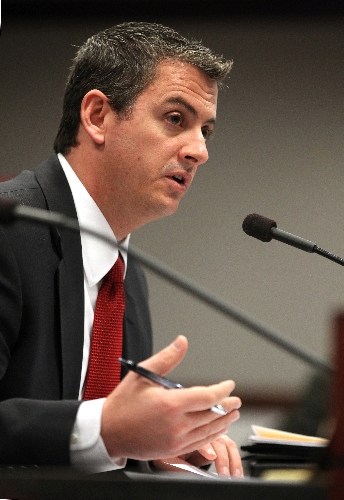Taxpayers would gain but state could lose under proposed pay cuts, panel told

CARSON CITY — Proposed state employee pay cuts and salary freezes would save taxpayers nearly $600 million over the next two years, but could also cost state government valuable workers.
That’s according to testimony before the Assembly Ways and Means Committee from Republican Gov. Brian Sandoval’s top budget official and several state workers.
Andrew Clinger, director of the Department of Administration, said Sandoval’s proposed 5 percent cut in state worker pay would save $379.7 million. An additional $211.8 million in savings would be generated by salary freezes, suspension of raises and elimination of state funding for extra pay to teachers who earn advanced degrees.
Of the $591.5 million in proposed savings, $490 million comes from K-12 and higher education. The pay cuts can be achieved without harming the state’s ability to offer competitive wages and benefits to attract employees, according to Clinger and Teresa Thienhaus, the state’s director of personnel.
"We are still offering what people in global employment surveys want," Thienhaus said. "Compensation is one part of it, but it is not the key part. The key issue is job security."
But skeptical lawmakers and other witnesses, including state workers, said Sandoval’s proposals to balance the budget without raising taxes can only be characterized as damaging to the education system and the state as a whole.
"Everything we do in this session is going to impact families in some way," said Assemblywoman Maggie Carlton, D-Las Vegas. "This is not about statistics and numbers, this is about families who are trying to survive."
Carlton and other Democrats said pay cuts and plans to change retirement benefits for future employees to a two-part system would hurt the state over time.
The first part of the proposed change to the retirement system would be a defined benefits plan, such as PERS, except the workers would receive just 1.25 percent per year with a cap on retirement pay at about 35 percent of salary. The second part would be a defined contribution plan, similar to a 401(k), which would include an employee contribution plus a state match.
The Democrats were especially concerned that the changes would drive away the best-performing employees, especially as the economy picks up and private employers begin hiring. "They are going to be ripe for the picking," said Assemblyman Marcus Conklin, D-Las Vegas.
Others said the cuts are too much to ask of state employees, especially those who work in demanding environments such as prisons.
Ronald Bratsch, a prison guard and representative of the American Federation of State, County and Municipal Employees, described recent incidents in which a prison kitchen worker was clubbed into a coma and a 70-year-old prison nurse was attacked by an inmate.
Bratsch said prison workers count on regular raises and adequate staffing levels to stay motivated.
"It is something that we were promised when we got our position," he said. "I put my life at risk on a daily basis."
In addition to pay cuts, Sandoval is looking to reduce the amount of paid time off workers receive and cut down on extra pay for holidays.
For example, the state would save $2.7 million in the upcoming budget by reducing pay for employees who work holidays from double-time and a half to double-time, Clinger said.
Sandoval also proposes reducing sick leave from 120 to 96 hours per year, a number that reflects the average of 10 Western states.
The proposed budget also would add another tier of vacation accrual for workers who have been with the state less than five years.
Currently, workers get 120 hours of non-sick leave per year for the first 10 years on the job. Under Sandoval’s plan, workers would get 96 hours their first five years and 120 for years six through 10. "I don’t know if there are any private-sector employers out there that provide these types of leave accruals," Clinger said.
Contact reporter Benjamin Spillman at bspillman@reviewjournal.com or 702-477-3861.












